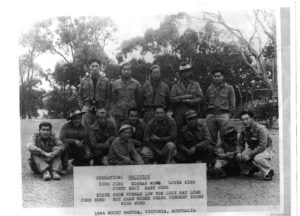 When Canada joined Britain and France in the war against Germany, the Chinese across Canada were strongly divided. Should they volunteer to fight for a country that treated them so poorly? On the other hand, the war opened a door for them to prove their patriotism and ultimately gain the right to vote. To this end, enthusiasts lined up to enlist. Lock’s older brother Earl and his cousin and kung fu master Jimmy Lore were among the many to be turned away by recruiters who deemed them unsuitable because of their ethnicity. Lock’s recruiter had a different opinion, and he enlisted without incident.
When Canada joined Britain and France in the war against Germany, the Chinese across Canada were strongly divided. Should they volunteer to fight for a country that treated them so poorly? On the other hand, the war opened a door for them to prove their patriotism and ultimately gain the right to vote. To this end, enthusiasts lined up to enlist. Lock’s older brother Earl and his cousin and kung fu master Jimmy Lore were among the many to be turned away by recruiters who deemed them unsuitable because of their ethnicity. Lock’s recruiter had a different opinion, and he enlisted without incident.
A turning point for the Chinese in Canada was the bombing of Pearl Harbor and Canada’s declaration of war against Japan. Canada and China were now allies against a common enemy. In 1944, conscription was expanded to include Chinese Canadians, who became regarded as assets in the Pacific war arena, where they could easily blend in behind enemy lines.
Lock went above and beyond the call of duty. Once again he volunteered, this time for a covert mission to sabotage, infiltrate and spy behind enemy lines. Operation Oblivion was the code name, with a casualty rate projected at 80 per cent. Toughened on the streets during his youth, he was well-positioned for this elite guerrilla unit of Chinese Canadians. Intensive training, with a suicide capsule among the supplies, included jungle survival, demolition with explosives, parachute landing and medic assistance.
Lock returned home safely after the war to the welcoming arms of his family at Union Station; however, he had one more battle to win. During his commando training in Australia, Lock had met and married Joan Lim On. They were now a stateless couple. Lock couldn’t settle in Australia because of its White Australia policy, and his wife was not allowed into Canada due to the Chinese Immigration Act. A special Order in Council eventually granted her entry as a war bride, one of a handful of Chinese immigrants who entered Canada during the 24 years of exclusion.
Armed with impressive credentials and reference letters from two Nobel laureates, Dr. Frank Macfarlane Burnet and Toronto’s Dr. Charles Best, a co-discoverer of insulin, she was immediately hired as a microbiologist at the Hospital for Sick Children. With financial aid from the Veterans Rehabilitation Act, Lock enrolled at the University of Toronto, where he and his friend Sam Chin were the first Chinese graduates from the School of Pharmacy.
The life-and-death precision of his wartime training had laid the groundwork for his chosen profession. Tom Lock Drug Store opened in 1954 at 136 Dundas St. W. in the heart of Chinatown. Lock became Toronto’s first pharmacist of Chinese descent, and proprietor of the first Chinese-owned pharmacy in Canada east of the Rockies.
Fondly remembered as an outgoing personality with his own brand of humour and “Lock-talk” expressions, he served his community at the drugstore for 22 years. Lock lived life to the fullest for 88 years until his passing in 2003, leaving the legacy of a lasting impact on others. His first-hand experience, especially with the aging Chinese men living on the streets and in rundown rooming houses, strengthened his resolve to do more.
He was a founding member and long-serving board director of the Mon Sheong Foundation, the first Chinese charitable organization in Canada. In 1975, the Mon Sheong Home for the Aged opened near Chinatown with 65 beds as the first residential facility in Ontario for Chinese senior citizens. This association coexisted with other institutions, such as the Chinese Canadian Institute and the Chinese United Church, located down the street from Lock’s pharmacy.
Lock’s contribution lives on at the Mon Sheong Foundation, which has expanded its facilities to 457 beds in the Greater Toronto Area. And Chinese Canadians such as Lock, who enlisted in the armed forces during the Second World War, played a pivotal role in bringing about fundamental changes for the Chinese in Canada: gaining the right to vote, obtaining full citizenship and seeing the repeal of the Chinese Immigration Act. Lock’s prescription for life served him well to the benefit of his fellow Canadians.
Excerpt from The Ward Uncovered (2018), published by Coach House Books.
Image Credit: Hank Wong

A truly wonderful and inspiring story…Thank you for posting it.
Thank you for your comment Jim!